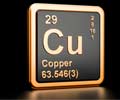Demonstrating rapid payback on the capital investment, a unique health economics assessment of copper's role in preventing healthcare-associated infections (HCAIs) is being presented this week at the WHO's International Conference on Prevention and Infection Control (ICPIC) in Geneva.

The pathogens that cause HCAIs can survive in the environment for days, even months, providing reservoirs of infectious agents on frequently-touched surfaces. Durable and effective antimicrobial copper surfaces offer an engineering solution that can serve as an additional line of defence against these pathogens. Copper and copper alloy touch surfaces (collectively termed 'antimicrobial copper') have been shown to continuously and significantly reduce bioburden by >90 per cent in clinical trials in Chile, the UK and the US.
Additionally, the most recently-published data from a US Department of Defense trial conducted in the ICUs of three hospitals shows that the replacement of six near-patient surfaces with antimicrobial copper equivalents was associated with a 58 per cent reduction in HCAIs.The YHEC study investigated the cost-effectiveness of a copper intervention, comparing expenditure on components with improvements in patient outcomes and other tangible benefits. This investigation allowed the derivation of a spreadsheet-based model that uses the best current, published information and shows the rapid return on investment of a copper intervention.
It also calculates the impact on bed days and quality-adjusted life years (QALY). The model is simple, transparent and fully referenced, and allows input of data for adaptation to specific local settings. Using UK data, the model predicts that the cost of replacing six key, frequently-touched surfaces in a 20-bed ICU with antimicrobial copper equivalents will be recouped in less than two months, based on fewer infections and the resulting shorter lengths of stay. Dr Matthew Taylor, YHEC's Director and one of the paper's authors, notes: "After the initial two months, ongoing cost savings will accrue from the reduction in blocked beds and better-directed staff resources." Over five years, the copper intervention is shown to save almost £2 million in reduced cost of HCAIs compared to traditional components, if fitted during a planned build or refurbishment.
While the total cost of the copper intervention is £30,600 higher than traditional components, over a five-year period, it is shown to result in a cost per infection averted of just £94.10.In conclusion, Dr Taylor points out: "This is not a typical health economics evaluation as there are confounding factors regarding the responsibility for budgetary spend in hospitals. This is an engineering solution needing capital budget (typically held by Facilities/Estates), but with an impact on infection prevention, cost of care and clinical outcomes.
It therefore requires a high degree of understanding and collaboration at senior decision-making levels."
Advertisement












